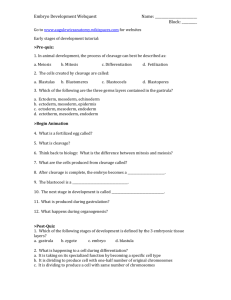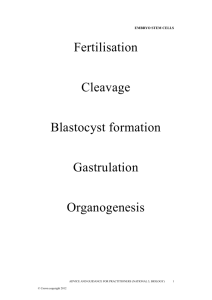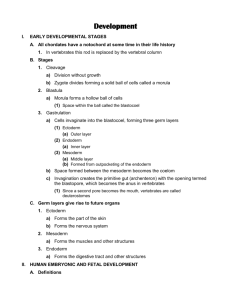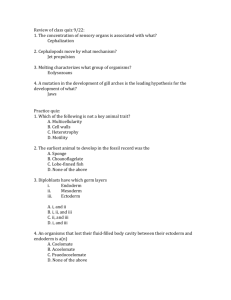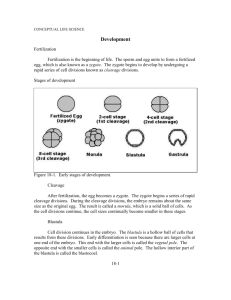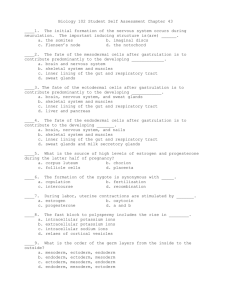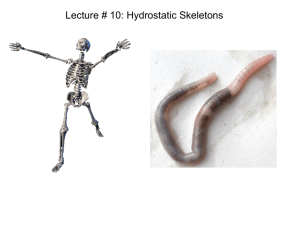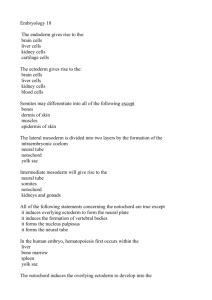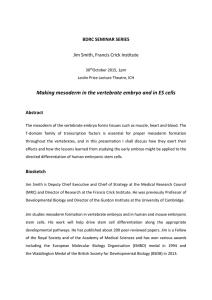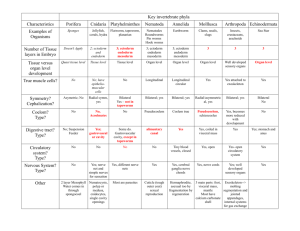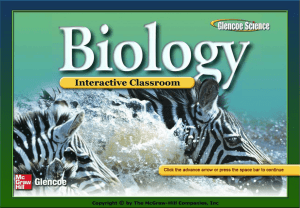Mesoderm
advertisement
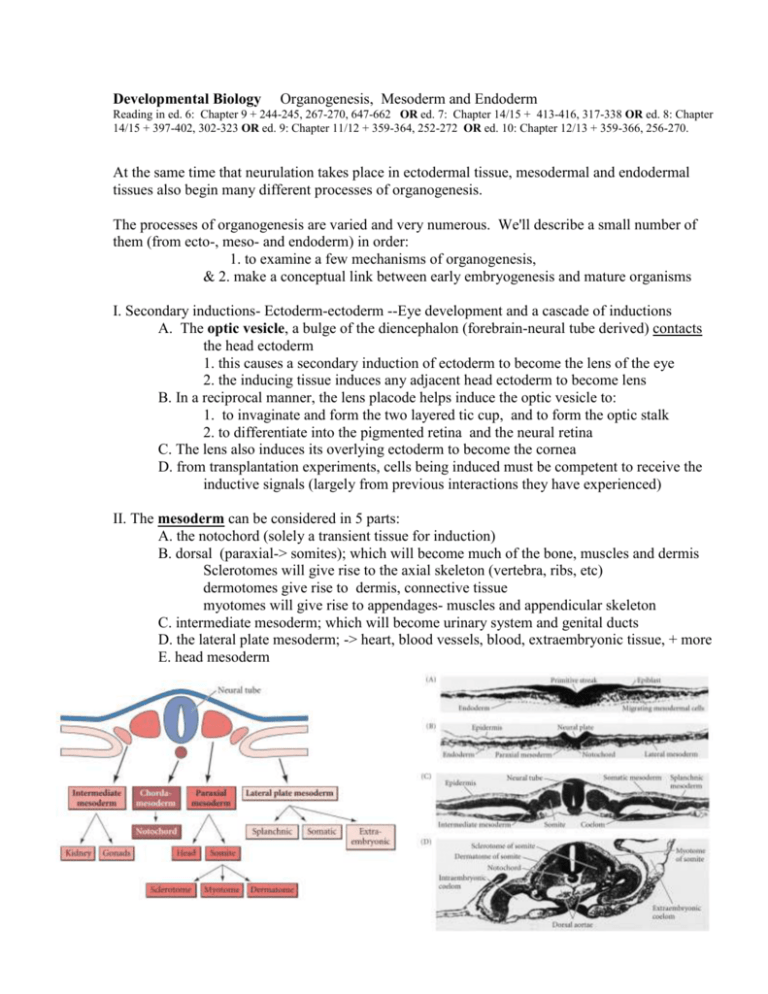
Developmental Biology Organogenesis, Mesoderm and Endoderm Reading in ed. 6: Chapter 9 + 244-245, 267-270, 647-662 OR ed. 7: Chapter 14/15 + 413-416, 317-338 OR ed. 8: Chapter 14/15 + 397-402, 302-323 OR ed. 9: Chapter 11/12 + 359-364, 252-272 OR ed. 10: Chapter 12/13 + 359-366, 256-270. At the same time that neurulation takes place in ectodermal tissue, mesodermal and endodermal tissues also begin many different processes of organogenesis. The processes of organogenesis are varied and very numerous. We'll describe a small number of them (from ecto-, meso- and endoderm) in order: 1. to examine a few mechanisms of organogenesis, & 2. make a conceptual link between early embryogenesis and mature organisms I. Secondary inductions- Ectoderm-ectoderm --Eye development and a cascade of inductions A. The optic vesicle, a bulge of the diencephalon (forebrain-neural tube derived) contacts the head ectoderm 1. this causes a secondary induction of ectoderm to become the lens of the eye 2. the inducing tissue induces any adjacent head ectoderm to become lens B. In a reciprocal manner, the lens placode helps induce the optic vesicle to: 1. to invaginate and form the two layered tic cup, and to form the optic stalk 2. to differentiate into the pigmented retina and the neural retina C. The lens also induces its overlying ectoderm to become the cornea D. from transplantation experiments, cells being induced must be competent to receive the inductive signals (largely from previous interactions they have experienced) II. The mesoderm can be considered in 5 parts: A. the notochord (solely a transient tissue for induction) B. dorsal (paraxial-> somites); which will become much of the bone, muscles and dermis Sclerotomes will give rise to the axial skeleton (vertebra, ribs, etc) dermotomes give rise to dermis, connective tissue myotomes will give rise to appendages- muscles and appendicular skeleton C. intermediate mesoderm; which will become urinary system and genital ducts D. the lateral plate mesoderm; -> heart, blood vessels, blood, extraembryonic tissue, + more E. head mesoderm III. We'll look at examples of mesodermal organogenesis on the organ and cell levels: A. The heart is derived from the splanchnic mesoderm (part of lateral mesoderm) in a very anterior part of the neurulating embryo-then migrates posteriorly 1.The presumptive heart cells make a two layered tube- of epimyocardium and endocardium, in the ventral part of the embryo in the pericardial cavity 2. They start as two halves which move in laterally, join, then later fuse B. At the cellular level- myogenesis-cell recognition, alignment, and fusion 1. myoblasts which give rise to skeletal muscle start as mononucleate myoblasts 2. they proliferate, migrate, then line up as long adjacent elongated cells 3. after recognition; proliferation and DNA synthesis stops, cells leave the cell cycle 4. Cells then fuse to make myotubules, - multinucleate cells-make up skeletal muscle 5. The gene expression, and hence the enzymatic makeup of the cells can be seen to change as they differentiate morphogenically IV. Endoderm gives rise to linings of two tubes (and of the pharynx, the common part of both tubes) A. the digestive tube, which has buds which also form the liver, gallbladder, and pancreas 1. the sphlanic mesoderm and endoderm pinches in toward the center of the embryo and produces pouches which are the foregut and hindgut. 2. the foregut and hindgut effectively "lengthen" while becoming more isolated from the yolk sac, and become the digestive tract 3. buds form along the digestive tract which will become the liver and the inner parts of the gallbladder and pancreas a. all of these differentiate into the proper tissues largely according to the inductive instructions of the neighboring mesenchymal tissue (see lung below) b. as in the case of pancreas, it can be shown that cell differentiation and specific gene expression happens coordinately with the morphogenetic changes c. these organs are also composed of mesenchymal tissue, (often surrounding the endodermal derived tissue) so that adjoining tissues from different germ layers combine and fuse to form the mature tissue B. the respiratory tube (which essential buds off from the primitive gut) differentiates only in the presence of mesenchyme 1. in the absence of mesenchymal tissue, if fails to differentiate 2. in the presence of mesenchymal tissues which are adjacent to the endoderm, the lung bud differentiates strictly according to the adjacent mesenchyme's identity a. if transplanted next to intestinal mesenchyme, forms villi b. if transplanted next to liver mesenchyme, forms hepatic structures, etc. V. The fact that vertebrates are very similar at very early ages was noted in 1828 by von Baer. He derived generalizations important for forming a framework for development and evolution A. general features of a phylum appear earlier in an embryo than specialized features B. subsequently, less general, then the most specific characters appear C. Each embryo of a species is similar to other species' embryos within the phylum, but departs more and more from the form of other adult animals as it develops -Darwin said that "community of embryonic structure...reveals community of decent" -Haekel later stated that : "Ontogeny [the development of an individual] recapitulates phylogeny" [the evolutionary history of the species within the phylum]-- that the early higher animal embryo actu-ally passes through the evolutionary development of its class. While this is not wholly correct, it’s been the basis for examining relationships of development, species comparisons and evolution for a century.
